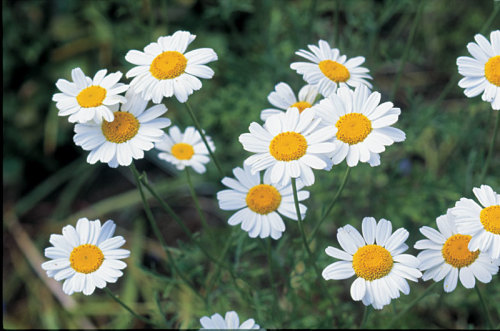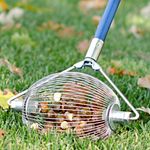
by William Olkowski, Sheila Darr, and Helga Olkowski
October 2000
from issue #29
Gardeners who follow Integrated Pest Management (IPM) practices have many options before they consider using a toxic pesticide. The first step in IPM is monitoring for the problem, then employing mechanical methods of control. This includes hand-picking or spraying with a stream of water. The next choice in an IPM regimen may be Bt, a selective microbial insecticide that does not harm natural enemies. Alas, at this time, there are Bt formulations available only for caterpillars, some immature flies, and certain beetles. With other chewing or sucking insects, what can you do? Your first option would be to try an oil or a combination soap and oil spray. Then, as a last resort, you might consider stepping up to a pyrethrum-based insecticide.
Pyrethrum is derived from the flower of Chrysanthemum cinerariaefolium. You might think that because it is derived from a natural source, a pyrethrum-based product is automatically safe. If you follow the directions for use on the package, it is relatively safe for people and pets, but it is unquestionably a true poison and will kill all insects it comes in contact with, both pests and beneficial insects alike. The most commonly available pyrethrum-based insecticides contain extracts from the flowers called pyrethrins.
The advantage in the vegetable garden is that a pyrethrin insecticide is effective against a wide variety of hard-to-kill insects like aphids, beetles, leafhoppers, and certain caterpillars. Because pyrethrins degrade rapidly in sunlight, they usually disappear from the garden within 24 hours, allowing you to pick your produce not long after spraying.
Pyrethrum, pyrethrins, pyrethroid…confused?
You’re not alone if you find the names of these insecticides perplexing. Understanding the terms is the first step in choosing the appropriate insecticide. Pyrethrum is the dried, powdered flower heads from the plant. It can be purchased as a powder in some garden centers. Pyrethrins are the active ingredients found in the dried flower heads. (Sometimes you will see the active ingredient referred to as pyrethrin, but there is more than one active chemical in the powder, so the active ingredient should be referred to as pyrethrins.) Pyrethrins usually come as a liquid that is put into solution with water and used in conventional spray equipment. Pyrethroids are the imposters—synthetic, man-made pyrethrins.
| What’s in a name?
Pyrethrum is the dried, powdered flower heads of certain chrysanthemum species. Pyrethrins are the active ingredients found in the dried flower heads. Pyrethrins degrade approximately 24 hours after spraying. Piperonyl butoxide (PBO) is an additive that increases the effectiveness of pyrethrins. It has recently been discovered that PBO is an active ingredient itself, and as such, it is not yet widely accepted by organic growers. Pyrethroids are synthetic, man-made chemicals based on the pyrethrins found in the dried flower heads of certain chrysanthemum species. Pyrethroids have a long residual period after spraying and are thus more lethal to a wider range of insects than pyrethrins. Pyrethroids are not considered organic. Permethrin is a common synthetic pyrethroid that also contains chlorine. This has a very long residual life, so avoid using it on food crops. |
|
Pyrethroids are a great example of how a chemical can be highly toxic even though it is based on a botanical source. Chemists have taken pyrethrum as a model and formed a whole group of poisons that have a structure similar to that of the natural compounds. The -oid suffix indicates “something like,” so a pyrethroid is something like a pyrethrum. One of the most common pyrethroids is permethrin. The “per-” prefix, in this case means “chlorine,” which is the key to the higher toxicity of permethrin. Gardeners with food crops will want to avoid permethrin since it has a relatively long residual life (two months or more) and is more toxic than pyrethrum.
Another option is pyrethrins with PBO
Most of the world’s supply of pyrethrum comes from eastern Africa, which has the right climate and the labor force to pick the flowers by hand. This makes the product relatively expensive compared with many other insecticides. In addition, some insects have the ability to break down the pyrethrins and recover from exposure to the chemical. To lower the amount of active ingredient (and thus lower the cost) while increasing the toxicity, manufacturers began routinely adding another component: piperonyl butoxide (PBO). It was assumed that PBO had little or no toxicity alone and merely made the mixture more potent, so it was considered a synergist.
The combination of pyrethrins and PBO produced greater toxicity against the same population of insects than the ingredients used individually. However, in this case 2 + 2 did not equal 4, but 40 or 400 or more. The two components are believed to block different biochemical pathways in insects and thus overwhelm the detoxifying powers of an insect exposed to it, making it much more toxic to the insect.
Recently, after more testing, PBO has been classified as an active ingredient. Although PBO is derived from a botanical source, many organic certification systems have been reluctant to include it among the permitted materials. Consequently, there are products on the market with only pyrethrins as well as those with pyrethrins and PBO. The latter products are less expensive and more toxic than the pyrethrins alone, though not as toxic as a synthetic pyrethroid. If you cannot obtain the pyrethrins-only products, use those with PBO, particularly if the only other choices are yet-more-toxic insecticides. If the package label is too complicated to figure out, most nursery personnel will be able to decipher it for you. If no one can help you, it’s probably worth avoiding the chemical until you have more understandable information.
The importance of understanding toxicity levels
The ideal insecticide should kill the target pest without injuring non-target insects, other wildlife, or you, the gardener. Pyrethrins are toxic to a wide range of insects, not to just a selected few pests, so they are not an ideal pesticide. But since they have an extremely short residual life, they kill only the insects present at the time of application, minimizing the number of non-target pests killed, compared with most other commonly used poisons.
Pyrethrins have some selectivity with regard to mammals, since short-term (hours, days) exposure to skin or other parts of the human body does not lead to life-threatening or even health-threatening reactions. The only reported problems occurred with some people who were hypersensitive and who breathed in some of the material. These people may also have been reacting to various inert ingredients in the product they were using, and not to the pyrethrum itself. The respiratory problems once caused by using the ground flowers ceased when extracted pyrethrin products appeared on the market.
Pyrethrum is tried and true
It is possible that pyrethrum is one of the oldest insecticides known, and that in itself suggests its effectiveness and indicates acceptance by many people in many different situations. The ancient Chinese used the dried and powdered flowers as an insecticide and listed this material in a pharmacopoeia published around a.d. 100. The dried flowers were ground and added to an inert carrier to help deliver pyrethrins directly onto the insect.
Some modern seed catalogs carry Chrysanthemum cinerariaefolium, the flowers of which can be made into a pyrethrum in the same way. (We don’t advise this because the dust can cause respiratory problems.) Europeans learned about the powders and seeds of the plant when the Persians imported them in the early 1800s. In the early part of the 20th century, the insecticide was exported from Europe to the United States. Because pyrethrum-based products have had many incarnations over time, it is best to be informed when buying and using them, as some are much more toxic than others.
Fine Gardening Recommended Products

Greenworks 40V 14" Chainsaw, 2.5Ah USB Battery and Charger Included
Fine Gardening receives a commission for items purchased through links on this site, including Amazon Associates and other affiliate advertising programs.

Medium Nut Wizard 14" for English Walnuts, Chestnuts, Golf Balls
Fine Gardening receives a commission for items purchased through links on this site, including Amazon Associates and other affiliate advertising programs.

Ho-Mi Digger - Korean Triangle Blade
Fine Gardening receives a commission for items purchased through links on this site, including Amazon Associates and other affiliate advertising programs.


















Comments
Log in or create an account to post a comment.
Sign up Log in